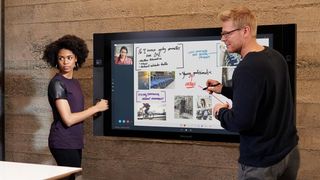9 things you might not know about the Microsoft Surface Hub
Mystery glass, Pictionary parties

Ever since Microsoft unveiled the exciting new Surface Hub, a digital whiteboard for offices and conference rooms, the major question has been: What will it cost? Now that we know it will run you $19,999 (about £13,000, AU$15,000) for the 84-inch 4K model and $6,999 (about £4,600, AU$5,350) for the 55-inch full HD model, I thought I'd break down a few interesting things you may not have heard about this gargantuan device.
1) Can you hear me now? We've all been on video conferences where noise pollution overshadows the main speaker. Those of us from major cities are especially familiar with the typical shrieks of passing ambulances and police cars. Fortunately, the Hub leverages Microsoft's Kinect technology to locate the direction of the most powerful voices near the device so that distant, ambient noise gets blocked out. So long ice cream truck music! Hello performance assessment dude!
2) I can see up your nose, brah: Unlike the webcam located at the top of your tablet, the Hub has two cameras along each side. This allows the speaker to more gracefully transition from one side of the unit to the other without exiting the video screen, or worse, blocking it completely with his/her big giant head.
3) Keep sexy selfies safe: You ever volunteer your laptop in the middle of a videoconference and accidentally open images or chat conversations you didn't want your coworkers to see? Well, with the Hub, all content is automatically beamed onto the screen when an HDMI cable is connected. So no more fumbling around with tabs and file folders to find the setting that lets you output images. It will happen automatically.
4) No mo' B.O.: Presenters can edit original content directly from the Hub. So, if your smelly boss wants to mark up your PowerPoint, he/she doesn't have to lean over your shoulder to adjust content on your laptop to make an example of you in front of all your peers. With the Hub, your boss can make edits directly on the 84-inch screen and the edits will be reflected on the original file.

5) Wake up, slacker: Unlike with your laptop, you can't record meetings onto the Hub. So, bring a video camera or a tape recorder if you're planning to sleep during your boss' state of the union address. You can, however, receive an email directly from the Hub detailing all of the visual edits and drawings your boss made onto the whiteboard.
6) Not for Avatar: The Hub does not output 3D video or stills. There are displays on the market designed for instruction, like the HP Zvr, that come with 3D glasses so that teachers and supervisors can provide step-by-step virtual direction for surgeons and pilots, among other professions.
Are you a pro? Subscribe to our newsletter
Sign up to the TechRadar Pro newsletter to get all the top news, opinion, features and guidance your business needs to succeed!

7) A Hub for your orgy: If you want to get really wacky, the Surface Hub can receive input from up to six pens at one time. However, only three presenters can ink at once. I envision this being particularly useful for after-hours group Pictionary sessions. However, I guess it can also be useful for design teams making edits to large format images, or multiple presenters making notes during a brainstorm.
8) App're vous: All core Microsoft apps are free whenever you purchase a Hub. So if that monthly $9.99 Office subscription is what's keeping you from purchasing the $20,000 Hub, rest assured, Microsoft has chosen to be the bigger person and it has added the subscription gratis.
9) The Glassy Knoll: Microsoft is not revealing the manufacturer that makes the Hub's screen. Here's what we do know: The Surface Pro 3 is made of Corning Gorilla Glass 3. We also know that Microsoft has received a lot of flack for the weakness of the Surface Pro 3's screen. I'd venture a guess that Corning is still the manufacturer, but Microsoft doesn't want to pull the bandage off of that wound by mentioning that partnership again. That could absolutely be 100% false, but I love a good conspiracy theory.
- Read our initial reaction to the Microsoft Surface Hub
Most Popular
